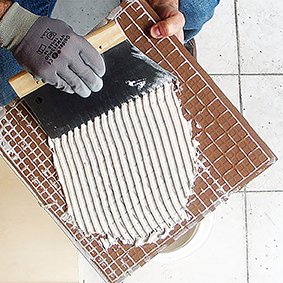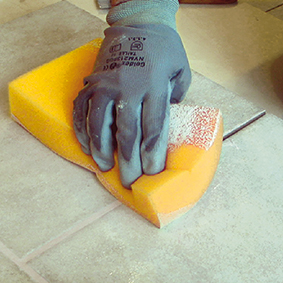LITTLE TIPS & TRICKS
FOR LAYING YOUR TILES
A TILER TOLD ME...
On what criteria to choose your tiling? :
In addition to the criteria of colors and patterns, it is first necessary to determine the destination of the area to be tiled. For this there are standards that apply to tiles at their destination, especially the floor.
The PEI classification measures resistance to abrasion and wear and corresponds to standard NF EN 14411 (2016). this is the abrasion resistance (wear by friction of mechanical bodies) of the tile enamel. There are 6 classes of PEI. Examples:
PEI 1: bathrooms, low traffic, weak abrasion: porcelain stoneware or glazed stoneware, mosaic, (be careful, earthenware only for the walls)
PEI 5: Corridors, places of intensive passage, high traffic: we will rather choose an unglazed full-body porcelain stoneware tile.
The UPEC French classification is established by CSTB for manufacturers who request this service. the UPEC classification (composed in UPEC U2 / UPEC U2s / UPEC U3 / UPEC U3s) corresponds to a score of 1 to 4 given on each of the following 4 criteria:
U: Walking wear: U1 to U4
P: Punching - falling object, piece of furniture on casters: P1 to P4
E: Water resistance - behavior in the face of water and humidity: E0 to E3
C: Chemistry - Resistance to stains and chemical agents: C0 to C3
Examples:
Individual houses: Entrance, living room> U2s P2 E1 C0 - Kitchen> U3 P2 E2 C2
A thick tile is therefore not necessarily a guarantee of resistance and good durability over time, check the classification carefully before purchasing, because the higher the PEI / UPEC figure, the greater the resistance.
Tile over screed:
Before being tiled, a screed must dry for at least 4 weeks (28 days). To speed up drying, you can use an electric (or cartridge) dehumidifier or add certain liquid drying additives. Think about it when planning your work. Never start tiling without testing the flatness of the screed. Use a mason's ruler with a spirit level: this will allow you to check the flatness over a large area and more easily detect imperfections. Finally, the floor must always be degreased before proceeding with the installation. Reduce soil acidity using alkaline products (dishwashing liquid, kitchen degreaser). Indeed, a cleaned support allows a good adhesion of the glue for an impeccable result.

The cement veil (ou "laitance") :
It is the most painful part of the installation, this whitish veil ruins the beautiful effect of your new tiling just after the joints have dried. Do not wait to remove it, the more it dries and the more it will be complicated to remove. For this there are dedicated products on the market. You can also use white vinegar, which is more common and cheaper, or largely diluted citric acid. Do not forget the scratching or stripping pads, for finishing, and always rinse thoroughly with an industrial sponge, making large, wide gestures in a semi-circle.
If, after several days several weeks, whitish traces appear again on the floor tiles, it may be a rise of the mortar laitance. These traces are easily removed with a special acidic cement haze remover (commercially available) or with water with hydrochloric acid added.




